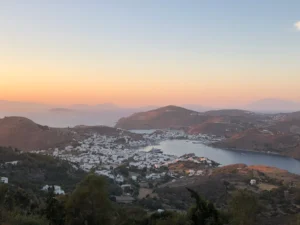
Patmos Imperiled: The Catastrophic Ecological and Cultural Impact of Cruise Ships on a Cherished Island
There are few places in the world like Patmos. Revered for its spiritual legacy, the island whispers of eternity. It was here that John the Theologian received the Revelation, and for centuries since, pilgrims have come seeking silence, wisdom, and renewal. The cave, the monastery, the winding paths between hills and bays—these are not just physical landmarks but sacred touchstones of memory and meaning. Patmos is not just an island; it is a living sanctuary.
And yet, this sanctuary stands on the brink of desecration.
The Hidden Pollution: Poison in the Water and Air
Cruise ships are not merely oversized ferries—they are among the most polluting forms of transportation on Earth. A single large vessel can emit more sulfur oxides than millions of cars. Their engines run constantly, burning heavy fuel oil, even while docked, spewing toxins into the air and onto the island. Many of these ships now use “open-loop scrubbers”—a technology designed to reduce airborne emissions by washing pollutants into the sea instead.
Let us be clear: what is removed from the smokestack is not eliminated. It is dumped—untreated—into the pristine waters that surround Patmos. The very bays that draw swimmers and marine life alike are slowly being poisoned with acidic runoff, heavy metals, and microplastics. The Aegean’s deep blue is being sacrificed for profits.
Ecosystem at the Brink
Patmos is a small island with a delicate balance. Its flora and fauna are tightly linked to the rhythm of the land and sea, a biodiversity that has endured for centuries. But cruise ship activity threatens this fragile ecology. The noise pollution underwater disorients marine life, from fish to the rare Mediterranean monk seal. Anchor drops and propeller wash damage the seafloor and seagrass beds—vital habitats for juvenile sea creatures and oxygen-producing ecosystems.
Meanwhile, thousands of feet trample ancient footpaths and fragile plant life with no awareness of what they step over. Wastewater systems are overloaded. The demand for freshwater spikes unsustainably. Small-scale fishermen, once the lifeblood of the island’s food system, now compete with industrial deliveries catering to mass tourism.
Cultural and Social Erosion
But the damage is not only ecological—it is cultural. The very soul of Patmos is under threat.
The island was never meant for mass tourism. It speaks to those seeking depth, not distraction. Its spiritual resonance, its artistic calm, and its contemplative beauty are incompatible with the frenzied energy of cruise crowds. Local shops are pressured to cater to passing trends rather than rooted traditions. Young people grow disillusioned, watching their heritage repackaged and sold in plastic. The intimacy of the island is lost in the noise of daytrippers who never stay the night, never taste the slow rhythm of island life.
What does it mean when a sacred place becomes a backdrop for selfies? When centuries of history are reduced to a ten-minute photo stop before the next destination? What is lost is not just tranquility—but reverence.
A Call for Responsible Reimagining
Patmos still has a choice.
It can say no to the model of extractive mass tourism and yes to a sustainable, three-season model that honors both the land and the people. It can welcome those who come to learn, to walk gently, to listen. It can promote bio-tourism, eco-tourism, and pilgrimage—not as niche trends, but as central pillars of an economy rooted in care and preservation.
Local farmers, craftspeople, spiritual guides, and artists can be supported, not replaced. The monastery and the Cave of the Apocalypse can remain living sites of pilgrimage, not overrun attractions. The island’s waters can be clean. Its hills can remain covered in thyme and wildflowers. Its soul can remain intact.
But this will only happen if the people of Patmos—and those who love it—raise their voices. If policies are put in place to limit or ban cruise ships, especially during the high summer season. If international awareness is drawn to the quiet catastrophe unfolding. If economic models shift from quantity to quality, from volume to value.
Conclusion: A Sacred Duty
Patmos is imperiled, but not lost. There is still time. The question is whether we—as visitors, citizens, and caretakers—will act before it is too late.
This is a sacred island. Let it remain sacred—not in word alone, but in how we protect it, how we visit it, and how we choose to carry its light into the future.
Let us not be remembered as the generation that turned Revelation Island into a dumping ground. Let us be the ones who stood up, who said no more, who restored balance—so that Patmos may continue to reveal, inspire, and shelter all those who come seeking something greater than themselves.